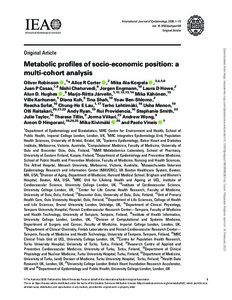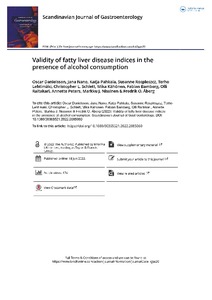Hae
Aineistot 1-10 / 12
Mitochondrial genome-wide analysis of nuclear DNA methylation quantitative trait loci
<p>Mitochondria have a complex communication network with the surrounding cell and can alter nuclear DNA methylation (DNAm). Variation in the mitochondrial DNA (mtDNA) has also been linked to differential DNAm. Genome-wide ...
BMI is positively associated with accelerated epigenetic aging in twin pairs discordant for body mass index
<p>Background <br>Obesity is a heritable complex phenotype that can increase the risk of age-related outcomes. Biological age can be estimated from DNA methylation (DNAm) using various "epigenetic clocks." Previous work ...
Long-term tracking and population characteristics of lipoprotein (a) in the Cardiovascular Risk in Young Finns Study
<p>Background and aims</p><p>Lipoprotein (a) (Lp(a)) is a causal risk factor for cardiovascular diseases and its levels are under strict genetic control. Therefore, it is hypothesized that the concentration of Lp(a) remains ...
Magical thinking in individuals with high polygenic risk for schizophrenia but no non-affective psychoses-a general population study
A strong genetic background for psychoses is well-established. Most individuals with a high genetic risk for schizophrenia, however, do not develop the disorder. We investigated whether individuals, who have a high genetic ...
Influential Periods in Longitudinal Clinical Cardiovascular Health Scores
<p>The prevalence of ideal cardiovascular health (CVH) among adults in the United States is low and decreases with age. Our objective was to identify specific age windows when the loss of CVH accelerates, to ascertain ...
Methylation status of nc886 epiallele reflects periconceptional conditions and is associated with glucose metabolism through nc886 RNAs
<p>Background</p><p>Non-coding RNA 886 (nc886) is coded from a maternally inherited metastable epiallele. We set out to investigate the determinants and dynamics of the methylation pattern at the nc886 epiallele and how ...
Metabolic profiles of socio-economic position: a multi-cohort analysis
<div><p><strong>Background: </strong>Low socio-economic position (SEP) is a risk factor for multiple health outcomes, but its molecular imprints in the body remain unclear.</p><p><strong>Methods: </strong>We examined SEP ...
Reproductive history and blood cell DNA methylation later in life: the Young Finns Study
<div><p><strong>Background: </strong> Women with a history of complications of pregnancy, including hypertensive disorders, gestational diabetes or an infant fetal growth restriction or preterm birth, are at higher risk ...
Uncovering the complex genetics of human temperament
<p>Experimental studies of learning suggest that human temperament may
depend on the molecular mechanisms for associative conditioning, which
are highly conserved in animals. The main genetic pathways for
associative ...
Validity of fatty liver disease indices in the presence of alcohol consumption
<p><strong>Background & aims: </strong>Non-alcoholic fatty liver disease (NAFLD) and alcohol-related liver disease frequently coexist. While several blood-based indices exist for the detection of NAFLD, few studies have examined how alcohol use possibly impacts their diagnostic performance. We analysed the effects of alcohol use on the performance of indices for detecting fatty liver disease (FLD).</p><p><strong>Methods: </strong>We included participants from the Cardiovascular Risk in Young Finns Study (Finnish sample) and KORA study (German sample) who underwent abdominal ultrasound or magnetic resonance imaging, respectively, for detection of FLD and had serum analyses available for calculation of Fatty Liver Index (FLI), Hepatic Steatosis Index (HSI), Lipid Accumulation Product (LAP), and Dallas Steatosis Index (DSI). Alcohol use was estimated by questionnaires as mean daily consumption and binge drinking (Finnish sample only). Predictive performance for FLD was assessed according to alcohol consumption.</p><p><strong>Results: </strong>The study included 1426 (Finnish sample) and 385 (German sample) individuals, of which 234 (16%) and 168 (44%) had FLD by imaging. When alcohol consumption was <50 g/day, all indices discriminated FLD with area under the receiver operating characteristics (AUROC) of 0.82-0.88. AUROCs were 0.61-0.66 among heavy drinkers (>50 g/day). AUROCs decreased to 0.74-0.80 in the highest binge-drinking category (>2 times/week). Alcohol use correlated with FLI and LAP (r-range 0.09-0.16, p-range <.001-.02) in both samples and with DSI (r = 0.13, p < .001) in the Finnish sample.</p><p><strong>Conclusions: </strong>Indices perform well and comparably for detection of FLD with alcohol consumption <50 g/day and with different binge-drinking behaviour.</p>...









